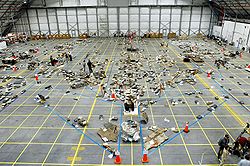NASA issues survivability report on Columbia crash
Friday, January 2, 2009

NASA has issued a report on survivability during the Space Shuttle Columbia disaster, entitled "Columbia Crew Survival Investigation Report". Although the report finds the accident was impossible to survive, it still faulted a number of design issues with the astronauts' equipment.
The accident investigation report was released in 2003, the year of the crash. During launch on January 16, the spacecraft's wing was holed when a chunk of foam detached and struck it. The shuttle then broke up on re-entry on February 1 over Texas, killing the seven on board.
This new report reveals details of what happened to the astronauts during the accident sequence, although some parts have remained confidential to the victims' families. The report reveals that within seconds of the breakup commencing the crew became unconscious due to the rapid depressurization and that they never regained consciousness prior to their deaths.
The report notes that the cabin began spinning wildly, causing some of the astronauts' helmets to come off. The report noted that most on board were secured only by lap harnesses that offered no restraint to the upper body and were not designed to cope with sideways motion, meaning "lethal trauma" was caused by the rotation. However, the report was unable to determine whether the astronauts had died from oxygen deprivation or the extreme nature of their injuries.

The pressure suits the crew wore, introduced after the Space Shuttle Challenger disaster, were criticised as the crew could not keep their visors down throughout re-entry due to a design limitation that would have caused excess levels of oxygen to be present had they done so, leaving the suits unsealed. The gloves also made many tasks difficult or impossible. When the accident occurred, three people were not wearing gloves, one was not wearing a helmet, and none had their visors down. The helmets also did not conform to the heads of the wearers.
Upon disintegration, the occupants were exposed to extreme heat and high friction from re-entry. The astronauts likely died very quickly, and were probably dead by the time Columbia broke apart.
The report added that although the crew all wore parachutes, they had to be activated by the crew — impossible as they were unconscious. The report concluded that future spacecraft require sturdier construction and better restraints, while safety devices should be automatic. NASA is designing better suits and helmets.
Sources
- "NASA report details last moments of Columbia crew" — Los Angeles Times, December 31, 2008
- "NASA: Columbia crew equipment didn't work well" — Newsday.com, December 30, 2008
External links

